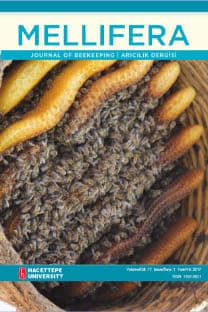İç Anadolu Bölgesi bazı bombus arısı (Bombus, Apidae, Hymenoptera) türlerinde allozim çeşitliliği
Bu çalışmada İç Anadolu 'nün çeşitli bölgelerinden toplanan Bombus Latreille cinsinden örnekler yatay nişasta-jel elektroforezi cihazı kullanılarak analiz edilmiştir. İncelenen sekiz türden yalnızca Bombus (Thoracobombus) humilis türü poümorfık olarak bulunmuştur. Bu türde ortalama heterozigotluk oldukça düşük olarak tespit edilirken (Ortalama heterozigotluk-0,19±0,19), diğer türlerde elektromorflann sabitlendiği gözlenmiştir. B. humilis populasyonlarmda tespit edilen bu durumun alttür seviyesinde mevcut bulunan karışıklıkların giderilmesinde yardımcı olacağı düşünülmektedir. Elektroforetik data kullanılarak çizilen fenogram da daha önce çeşitli araştırmacılar tarafından sunulan sistematik yapı ile uyumludur. Bu durum halen kullanılan altcins sisteminin bazı bombus arılarına evrimsel'açıdan uyumlu olduğunu ve bu nedenle doğal olarak kabul edilebileceği hipotezini desteklemektedir.
Allozyme variability in some central Anatolian bumble bee (Bombus, Apidae, Hymenoptera) species
In this study some bumble bees from the genus Bombus Latreille, which were collected from different localities in Central Anatolia, were analysed by horizontal starch-gel enzyme electrophoresis. Of the eight species examined, only Bombus (Thoracobombus) humilis were found to be polymorphic with low heterozygosity (Mean heterozygosity = 0.19±0.19), while the other species had distinct electromorphs fixed in different populations. The situation in B. humilis populations can be regarded as a possible reason for the confusion at subspecies level. The phenogram based on electrophoretic data showed the same systematic pattern proposed before by several authors. This supported the hypothesis that the sub generic system in some bumble bees reflects the evolutionary pathway and may be accepted as natural.
___
- 1. Kandemir, İ., Kence, A., Allozyme variability in a Central Anatolian honeybee (Apis mellifera L.) population, Apidologie, 26,503-510, 1995.
- 2. Kandemir, İ., Kence, M., Kence, A., Genetic and morphometric variation in honeybee (A. mellifera L.) populations of Turkey, Apidologie, 31, 1-14,2000.
- 3. Pamilo, P., Varvio-Aho, S., Pekkarinen, A., Low enzyme gene variability in hymenoptera as a consequence of haplodiploidy, Hereditas, 88, 93-99, 1978.
- 4. Pamilo, P., Pekkarinen, A., Varvio, S., Clustering of bumble bee subgenera based on interspecific genetic relationships (Hymenoptera, Apidae: Bombus and Psithyrus), Ann. Zool. Fennici, 24, 19-27, 1987.
- 5. Pamilo, P., Tengö, J., Rasmont, P., Pirhonen, K., Pekkarinen, A., Kaarnama, E., Pheromonal and enzyme genetic characteristics of the Bombus lucorum species complex in Northern Europe, Entomologica Fennica, Vol. 7,187-194, 1997.
- 6. Pekkarinen, A., Morphometric, colour and enzyme variation in bumble bees (Hymenoptera, Apidae, Bombus) in Fennoscandia and Denmark, Acta Zoologica Fennica, No: 158, Helsinki, 1-60, 1979.
- 7. Thorpe, J. P., Sole-Cava, A. M., The use of allozyme electrophoresis in invertebrate systematics, Zoologica Scripta,Vol.23,No: 1,3-18, 1994.
- 8. Rosenmeier, L., Packer, L. A., Comparision of genetic variation in two sibling species pairs of haplodiploid insects, Biochemical Genetics, Vol. 31, Nos., 3/4 185-200, 1993.
- 9. Engel, M. S., A monograph of the Baltic amber bees and evolution of the Apoidea (Hymenoptera), Bulletin of the American Museum of Natural History, Number 259, New York, 192p, 2001.
- 10. Rasmont, P., Flagothier, D., Biogeographie et choix floraux des bourdons (Hymenoptera, Apidae) de la Turquie, NATO-OTAN TU Pollination Project Report, Belgium, 68 p, 1996.
- 11. Richards, O. W., The subgeneric divisions of the genus Bombus Latreille (Hymenoptera: Apidae), Bull. Br. Mus. Nat. Hist. (Ent.), 22, 210-276, 1968.
- 12. Ito, M., Supraspecific classification of bumble bees based on characters of male genitalia, Zoological Section, The Institute of Low Temperature Science Publ., Hokkaido University, Japan, 143pp, 1985.
- 13. Koulianos, S., Schmid-Hempel, P., Phylogenetic relationships among bumble bees (Bombus, Latreille) inferred from mitochondrial cytochrome b and Cytochrome Oxidase I Sequences, Molecular Phylogenetics and Evolution, 14(3): March: p, 335-341, 2000.
- 14. Terzo M., Valterova, I., Urbanova, K., Rasmont, P., De la necessite de redecrire les pheromones sexuelles des males de bourdons [Hymenoptera, Apidae, Bombini] publiees avant 1996 pour leur utilisation en analyse phylogenetique, Phytoprotection, 84(2) 39-51, 2003.
- 15. Williams, P. H., A preliminary cladistic investigation of relationships among the bumble bees (Hymenoptera, Apidae), Systematic Entomology, 10: 239-255, 1985.
- 16. Ay tekin, A. M., Çağatay, N., A phenetic approach to the subgenera of bumble bBees (Hymenoptera: Apidae), Mellifera, Vol: 2, No: 3, 60-64,2002.
- 17. Williams, P. H., An annotated checklist of bumble bees with an analysis of patterns of description (Hymenoptera: Apidae, Bombini), Bulletin of the Natural History Museum, Entomology, 67, 79-152, 1998.
- 18. Rasmont, P., Catalogue commente des bourdons de la region ouest-palearctique, Notes Fauniques de Gembloux, No. 7. Belgique,71p, 1983.
- 19. Pawlikowski,T. A., Field guide to identification of bumble bees (Hymenoptera: Apidae: Bombini) in Poland, Wydawnictwo Uniwersytetu Mikolaja Kopernika, 30p, 1999.
- 20. Shaw, C. R., Prasad, R,, Starch gel electrophoresis of enzymes, A compilation of recipes, Biochemical Genetics, Vol. 4, 297-320, 1970.
- 21. Hillis, D. M., Moritz, C, Molecular systematics, Sinauer Assc, Inc., Sunderland, Massachusetts, USA, 588p. 1990.
- 22. Nei, M., Molecular evolutionary genetics, Columbia University Press, New York, 634p, 1987.
- 23. Swofford, D., Selander, R. B., Biosysy-1, Department of Genetics and Development, Illinois, 65p, 1981.
- 24. Aytekin, A. M., Ankara ili ve ilçeleri Apidae (Hymenoptera) familyası üzerinde sistematik araştırmalar ve bunların ayçiçeği (Helianthus annum L.) bitkisindeki pollinator eEtkileri üzerine ön-çalışmalar, Bilim Uzmanlığı Tezi, Hacettepe Üniversitesi Fen Bilimleri Enstitüsü, Ankara, 83s. 1996.
- ISSN: 1302-5821
- Başlangıç: 2001
- Yayıncı: Hacettepe Üniversitesi
Sayıdaki Diğer Makaleler
Raşiv K. GUPTA, Ravindra k. NAVAL, Santosh K. CHARAN, Abhishek RAJPUROHIT
Tüylü Aslı ÖZKÖK, Kadriye SORKUN
Propolisin suda çözünür bir türevinin fareler üzerindeki radyoaktif etkisi
Nada ORSOLİC, Zoran TADİC, Vesna BENKOVİÇ, Mirko LOJKİC, Ivan BASİC, Anica HORVAT
İç Anadolu Bölgesi bazı bombus arısı (Bombus, Apidae, Hymenoptera) türlerinde allozim çeşitliliği
